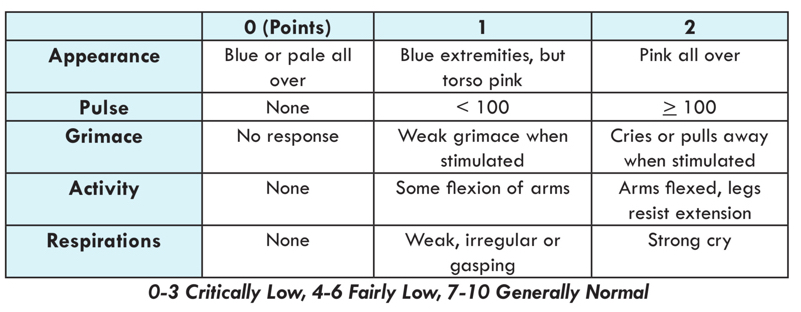 Dr. Virginia Apgar invented the Apgar score in 1952 as a simple and replicable method to quickly and summarily assess the health of newborn children immediately after birth. The Apgar scale is determined by evaluating the newborn on five simple criteria (Appearance, Pulse, Grimace, Activity, Respiration) on a scale from zero to two, then summing up the five values. The resulting Apgar score ranges from zero to 10.
Dr. Virginia Apgar invented the Apgar score in 1952 as a simple and replicable method to quickly and summarily assess the health of newborn children immediately after birth. The Apgar scale is determined by evaluating the newborn on five simple criteria (Appearance, Pulse, Grimace, Activity, Respiration) on a scale from zero to two, then summing up the five values. The resulting Apgar score ranges from zero to 10.
The test is generally done at one and five minutes after birth, and may be repeated later if the score is and remains low. Scores 7 and above are generally normal, 4 to 6 fairly low, and 3 and below are generally regarded as critically low.
The Apgar score is a quick and easy way to evaluate important traits, and it’s used in virtually every hospital in the world today.
It’s been said that all good ideas are borrowed and all great ideas are stolen. I recommend we “borrow” this good idea by developing a personalized version of the Apgar score.
For instance, a friend of mine is an executive vice president of a major corporation. Several years ago he was asked to take over the lowest-performing division in the company, which had more than 6,000 employees. He quickly determined that one major problem was the high rate of employee attrition. The high turnover rate not only disrupted business but every employee who left cost the company almost $50k (the cost of hiring and training an employee).
Instead of sitting behind his desk and trying to fix the problem from afar, he visited his team members out in the field where work takes place. He asked a lot of questions and listened well. He soon developed what he called “our personalized version of the Apgar Score.” He simply asked, “What common characteristics do our top employees share, and in particular, what is the profile of a worker who stays a long time with the company?”
Within a few months he had identified six attributes and behavioral characteristics of a successful and stable worker. His division adopted this method of scoring as the main tool for evaluating potential employees. Following every interview, the candidate would be given a score by those who interviewed him or her and only those who rated high in all six areas were hired. Within 12 months the attrition rate was reduced by 60 percent and the division went from being last to consistently being in the top two divisions in the country.
An Apgar score-type tool can be developed for most industries and positions and is a reliable predictor of success. It can be used to both evaluate prospective team members as well as train current team members. For instance:
- School principals develop an “Apgar score” for effective teachers.
- Sales managers, identify key traits of successful salespersons.
- Supervisors of computer programmers, develop a profile of the best in the field.
I think we’ll discover that some predictors of success for any given position are fairly obvious; most are hidden in plain sight. They just need to be identified and respected.
[reminder]What are your thoughts about this essay?[/reminder]
Summary
What? – For most positions, predictors of success can be identified.
So what? – Hire people who score high on these predictors of success and your organization will improve.
Now what? – Create a personalized “Apgar score” for various areas of your life.
Leaders – Years ago, I developed a set of criteria for effective leaders. I identified 12 indispensable skills that one must master in order to lead well. Click here for a list of the 12 skills. Go to learntoleadwell.com for more information on training opportunities.

Well Don, you were already high on my list of people I admire for their character and deep thinking but you raised yourself even higher using the Apgar score as the standard for quick and clear assessment. This system has been a foundation in my nursing practice for over 40 years. So you grabbed my attention from the first sentence which is a skill you effectively use time & time again. I am impressed by your broad exposure to professions other than your own.
Nancy, as a pediatric nurse I imagine you’ve used the Apgar score hundreds of times. It is a great idea applicable to many other areas of life. Thanks for being an important part of my grandsons life when he was first born. Don
What would an Apgar test look like for a retired person? One who isn’t employed but has been and was successful and satisfied in their working life?
I’m retired now but signed up for a course to become a Spiritual Director in January. I’m thinking this would be a good choice at this point in my life. I’m not planning to ever not be intimately involved in the discipleship of others to be a follower of Jesus.
I can’t think of a way to apply this to my situation now. thank you, Don. I think your posts are excellent and always stimulating.
Thanks, Susan, for sharing your thoughts. It would be very interesting to develop an Apgar score for happy and productive retirees. I think it would include things like: lifelong learning, staying physically active, be socially engaged, etc. To develop predictors of success in any area, we can study the lives of exemplary people. You might do an unofficial survey of fellow retirees whom you admire.